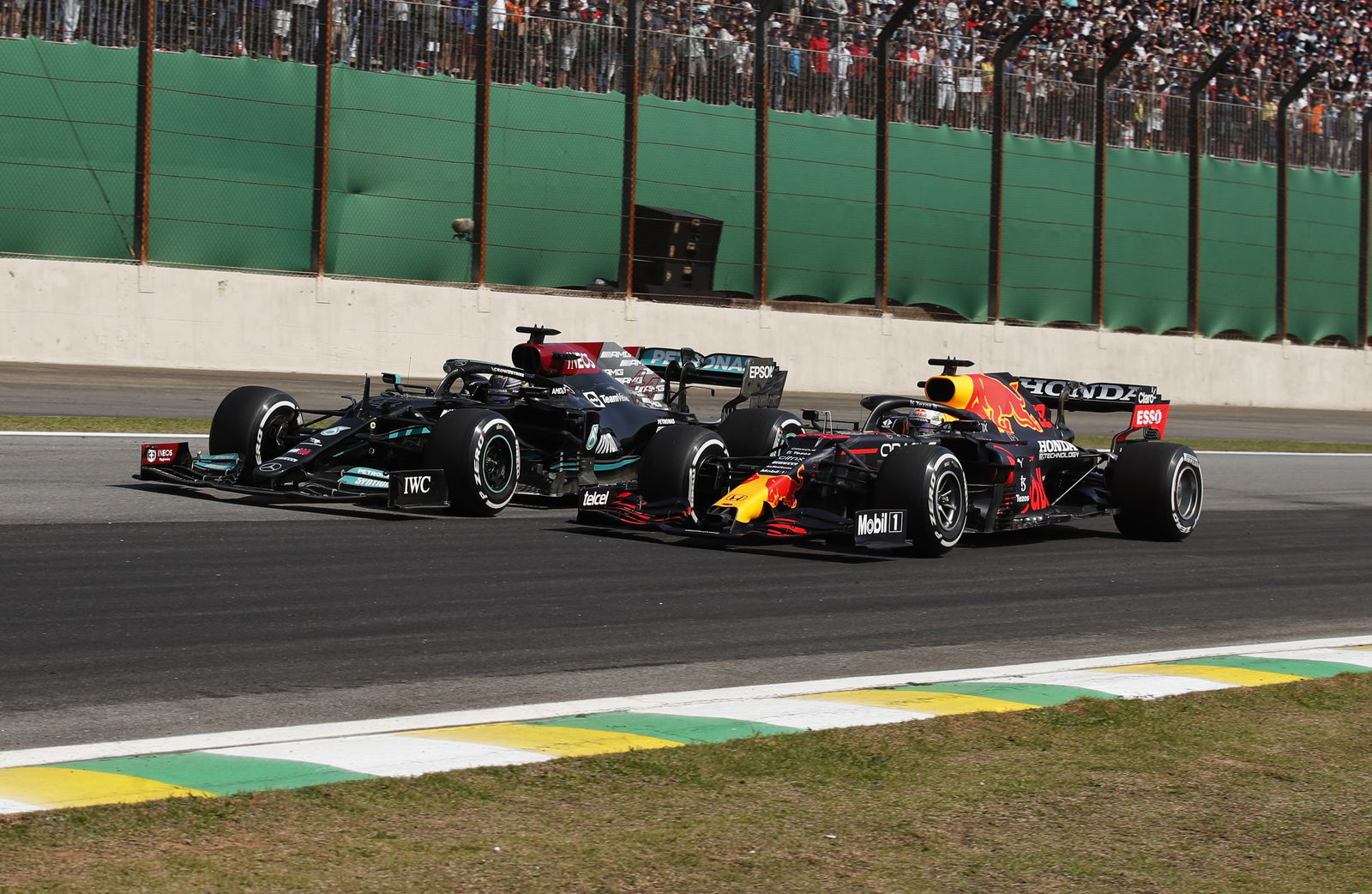The F1 stewards’ full verdict on Mercedes’ rejected review request

The Competitor provided the Stewards with a letter dated 16 November 2021 with Appendices setting out its arguments in support of the Petition.
Pursuant to Art. 14 of the ISC, a petition for review must be filed against a Stewards' decision and can only be granted if a Competitor successfully demonstrates "that a significant and relevant new element is discovered which was unavailable to the parties seeking the review at the time of the decision concerned." Provided that there is a Stewards' decision, the four key points that the Competitor must demonstrate are that the new element must be (i) Significant, (ii) Relevant (iii) New; and (iv) Unavailable at the time to the parties seeking the review at the time of the decision concerned.
Here, the Competitor points, in particular, to the forward-facing onboard camera footage and the 360° onboard camera footage from Car 33 (the "Footage"), which had to be downloaded after the race as the elements supporting the request for a Right to Review hearing.
It is important to note that the following is not an affirmation or review of the Stewards determination made during the race, but rather is an assessment regarding whether the Right of Review exists.
"The Decision”
With respect to "Incidents during the race", Art. 47.1 of the 2021 FIA Formula One Sporting Regulations (the "SR") states:
"The Race Director may report any on-track incident or suspected breach of these Sporting Regulations or the Code (an "Incident") to the stewards. After review it shall be at the discretion of the stewards to decide whether or not to proceed with an investigation. The stewards may also investigate an Incident noted by themselves." (emphasis added)
The stewards do not sit passively during a race and did not do so in this case. By the time the Race Director asked the Stewards for their view and stated that it was going to be "Noted" on the timing screens, they were already looking at the available footage. The subsequent discretionary decision of the Stewards not to proceed with a formal investigation is the motor racing equivalent of "Play-On" in other sports.
There will always be some angles of video footage, because of limits in both technology and bandwidth, that are unavailable at the time. Whether or not stewards' decisions are considered to be right or wrong, and just as with referees' decisions in soccer, it does not seem desirable to be able to review any or all such in-race discretionary decisions up to two weeks after the fact and the Stewards therefore seriously doubt that the intent of the Right of Review in the ISC is to enable competitors to seek a review of such discretionary decisions that do not follow on from a formal inquiry by the Stewards and do not result in a published document.
Despite the foregoing, Art. 47.1 of the SR applies to the present case as it explicitly states that it is up to "the stewards to decide whether or not to proceed with an investigation", whereas Art. 14 of the ISC refers to "the decision concerned" (small d). As a result, the Stewards in this very specific case determine that the "Turn 4 incident involving cars 33 (Ver) and 44 (Ham): no investigation necessary" constitutes a decision. Having said that and taking the four above-mentioned key points of the Right of Review in reverse order, the Stewards hereby make the following assessment:
Unavailable
It is undeniable that the Footage was unavailable to the Competitor at the time of the Stewards' Decision. Only a single channel of video from each car is available to the broadcaster and the Stewards at any given time and during the incident on Lap 48, the camera selected on Car 33 was the rear facing camera. This then means that it is also unavailable to the Competitor. While not available live, all the other cameras are recorded on-board the cars and are available for download post-race. This test is therefore met.
New
Many camera angles are not available live to the competitors but are to the Stewards. So, the Stewards considered whether footage that is simply not broadcast or not available to the competitors should be considered new. This is especially in light of the argument that this type of decision is the equivalent of "play on" in other sports.
The Competitor provided as an exhibit, Document 41 from the 2020 Austrian Grand Prix where the onboard 360° camera in that case, which was unavailable to both the team and the Stewards at the time of the initial hearing, was subsequently available and considered "new" by the Stewards at the time.
The Stewards consider this case to be similar and thus determine the test to be met.
Relevant
The Competitor proposed that the Footage was relevant because it was the only footage that allowed the overall position of the cars, the steering inputs of the driver of Car 33, the heading of the cars and the proximity of the cars to be analysed together. While the Stewards often have to make a decision with a limited set of facts, it is true that in making their review, the front facing camera was one of the angles that the Stewards looked for. The Footage is a direct view of the incident, is not extraneous and is therefore, in the Stewards opinion Relevant.
Significant
Whether this Footage is "significant" is really a question of whether or not it is likely to change the initial decision of the stewards.
In the pertinent example brought forward by the Competitor from Austria in 2020, none of the footage available and viewed at the time of the decision, showed a yellow flag visible to the driver (Lewis Hamilton.) However, the new and previously unavailable 360° camera footage, which was downloaded the next day, clearly showed that the yellow flag was visible from the car and the driver was penalized for failing to slow down. In that case, the footage absolutely changed the decision of the stewards and was thus significant. During the hearing, the Competitor asked that if the Stewards were unconvinced of the significance of the Footage, to be given the opportunity to present its view in that respect. Following the initial part of the hearing, the Stewards gave the Competitor the opportunity to do so, there being precedent for this. The previously unavailable Footage was played, and the Competitor also presented the Footage in a side-by-side comparison with the previous lap.
As noted above, the Stewards often must make a decision quickly and on a limited set of information. At the time of the decision, the Stewards felt they had sufficient information to make a decision, which subsequently broadly aligned with the immediate post-race comments of both drivers involved. Had they felt that the forward-facing camera video from Car 33 was crucial in order to take a decision, they would simply have placed the incident under investigation – to be investigated after the race – and rendered a decision after this video was available. They saw no need to do so.
The Competitor's position is that this new Footage provides sufficient information for the Stewards to come to an altogether different conclusion than they did previously. However, the Stewards determine that the Footage shows nothing exceptional that is particularly different from the other angles that were available to them at the time, or that particularly changes their decision that was based on the originally available footage. Unlike the 2020 Austria case, in the judgement of the Stewards, there is nothing in the Footage that fundamentally changes the facts. Nor even, does this show anything that wasn't considered by the Stewards at the time. Thus, the Stewards determine that the Footage, here, is not “Significant."
Conclusion
The Stewards find, in their sole discretion, that:
With the reservations raised above, the decision is subject to the Right of Review;
- That the Footage is New;
- That the Footage was Unavailable to the Competitor at the time of the decision subject to the petition for review;
- That the Footage is Relevant; but
- That the Footage is not Significant;
- The four key points required under Art. 14.1.1 are not met and the Stewards, therefore, deny the Competitor’s Right of Review.
Competitors are reminded that, in accordance with Art. 14.3 of the ISC, this decision is not subject to appeal.


